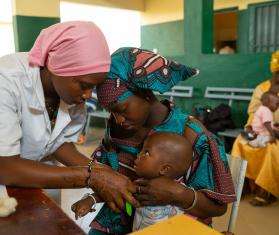Attacks have occurred repeatedly in recent months driving large numbers of people to leave their homes quickly. In the Lubero administrative region of northern North Kivu province, one local resident, speaking anonymously, described an event that took place in March: “It was 11:30 p.m. and we were asleep,” says M., from Miriki village. “We heard the sound of gunfire. At first, we thought it was attackers who were coming to loot. We stayed in our huts, but the gunfire continued for a long time so we decided to leave the village and head into the bush, everyone on their own."
Initially, the DRC army operation was conducted in conjunction with the Rwandan army but those troops pulled out in late February. Clashes continue in northern and western regions of North Kivu.
Several houses were burned during the Miriki attack. “At about 6:30 a.m., we saw a huge cloud of smoke in the village,” M. recalled. “We were on a nearby hillside and saw our huts burning. Mine burned, too, along with all my possessions.” M. left for the neighboring town of Kayna, where other displaced persons had also taken shelter.
Several Lubero communities have swelled with the influx of displaced persons, including Kayna and Kanyabayonga, whose population of 50,000 residents nearly doubled. The village of Luofu was similarly affected. It housed many displaced persons and was targeted by a deadly attack on the night of April 17, when more than 250 houses in the village were burned to the ground. Seven people died in the blaze. As always, the population sought safety in flight. People settled where they could – with host families, in makeshift shelters and in deserted houses.
“Local organizations and representatives of the displaced persons estimate that there are approximately 230,000 displaced persons in the Lubero region, but there are no camps,” says Romain Gitenet, MSF’s head of mission.
In response to these population movements, MSF extended its area of operations into the Lubero region. The MSF team based in Kayna provides care in Luofu, Kanyabayonga, Kirumba, Kayna, and Bingui and transfers seriously-ill patients to the Kayna hospital or the Kanyabayonga health center. With the situation in constant flux, MSF is adapting its operations, heading to those areas where populations are arriving and where the needs are most critical. Another team has been sent to work in the town of Lubero, further north.
Although the populations are exposed regularly to violence and looting, the attacks have produced limited injuries. “We are treating many fewer wounded patients than in October,” Gitenet says. “The armed factions are no longer engaged in head-on confrontation, as they were last September and October. This is more in the nature of guerrilla warfare.”
In late 2008, the conflict affected primarily the province's southern area. Fighting between the DRC army and the rebel National Congress for the Defense of the People prompted populations to flee to Goma. Today, the violence is focused in the north, around Lubero and Kayna. The situation is calmer in the south, although violence has not disappeared altogether. MSF teams are still there, providing medical and surgical care to populations weakened by years of conflict and to displaced persons living in the many camps.



